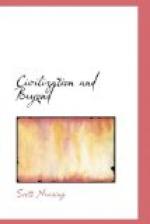At the moment, we have the satisfaction of orderly, beautiful neighborhoods at the same time that we are surrounded by a disorderly, littered, chaotic international battleground.
The earth with its oceans and its atmosphere is a storehouse containing many if not most of the essentials for survival, growth and development, for mankind as well as a multitude of other life forms. Perhaps its most valuable single asset from the human viewpoint is its topsoil. Topsoil plus light, air and moisture provide the elements necessary for producing vegetation. Vegetation, in its turn, furnishes the nourishment on which animals thrive.
At the top of our priority list for the well-being of the earth stands the injunction: conserve and build topsoil.
Topsoil is lost through erosion—wind erosion, water erosion, erosion through over cropping. It is held in place by stones, grasses, and the roots of shrubs and trees. Untouched by human hands, on the prairies and in the forests, topsoil is deepened year by year as winter frosts break up soft rocks, as dead grasses, leaves, twigs break down into humus, to become part of the topsoil and provide the nourishment for a new round of vegetation.
Topsoil is renewable, replaceable. Lost through cropping and erosion, it may be rebuilt and deepened by natural processes. In temperate climates with normal rain and snowfall, the topsoil of grasslands or a forest may be deepened year by year and century by century. Topsoil may also be deepened by dust storms that pick up particles of humus from dry lands and carry them to moister areas.
Through a carefully controlled sequence, semi-desert lands planted first to grasses and then to shrubs and trees can be protected against wind erosion. As vegetation flourishes it increases dew formation and rainfall. Plant roots prevent runoff and retain the water in gulleys and low places. Evaporation builds up moisture content in the atmosphere. Water vapor forms drops and falls in rain or snow.
Foresighted husbandry not only prevents erosion but, practiced on a sufficiently broad scale, increases air moisture and modifies climate—the weather.
We are less fortunate with some of the critically important minerals that make up the earth crust.
During early centuries in the history of western civilization adventurers and prospectors concentrated on the precious metals. The voyagers and discoverers who sailed fifteenth century seas were seeking supplies of gold, silver and precious stones that could be cut and converted into the highly prized jewels adorning the crowns and scepters of the mighty.
Production at that stage meant agriculture, with side occupations such as hunting, fishing, weaving, tanning, pottery, thatching and peat cutting, in the all but continuous countryside. There was a very little mining, but outside of the commercial towns and the growing capital cities people made their living by taking care of domestic animals and tilling the soil. Between seed time and harvest they tightened their belts and prayed the Powers that Be for a bountiful yield. If it came they feasted. If the crop failed they struggled to survive on the narrow margin between hunger and starvation.




